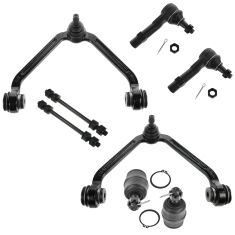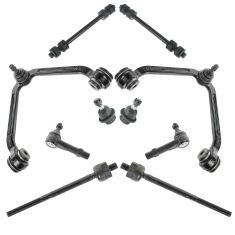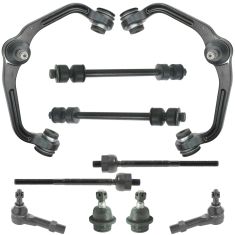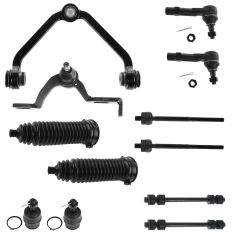1ASFK02616-Ford Mazda Mercury Front 10 Piece Steering & Suspension Kit TRQ PSA58980
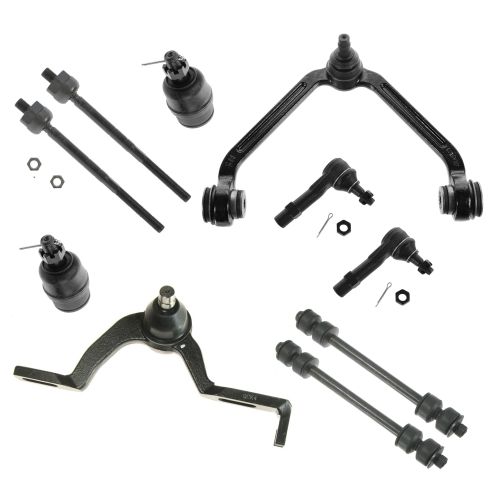
Replaces
2001 Mazda B3000 Truck DS with 2 Piece Passenger Side Upper Control Arm Front 10 Piece Steering & Suspension Kit TRQ PSA58980

Product Reviews
Loading reviews
4.55/ 5.0
11
11 reviews
Front Suspension Kit for 2003 Ford Ranger with 2wd and Torsion Bars
July 30, 2017
The kit was complete, relatively easy to install and gave my suspension a new-like feel.
All good except........
October 14, 2017
All parts except the inner tie rod ends were correct and fit perfectly. Your inner tie rods were the wrong part for my vehicle, found that out while I had the car up and taken apart so I had no choice but to run to the local parts store for correct parts and added cost.
December 17, 2017
Good product for the price point. Flawless transaction.
Wouldve been cooler if anything had grease fittings instead of being sealed. However, id buy again if i was in a non performance application, no questions.
Perfect
December 29, 2017
They are the best! Good quality parts right at your door super fast! Good quality people ready to help
All but one...
April 18, 2018
The price was right for the kit, but one of the outer tie rods had to be replaced at a local parts store. It was obviously loose when I installed it - could be moved by hand - easily.
A great experience
February 1, 2019
This was my first major purchase from 1A Auto. Fast delivery, I ordered the wrong parts, contacted customer service via email. They understood my mistake and handled the return/refund with great professionalism.
I ordered the correct parts which arrived within a few days.
Excellent suspension parts!!
Thank you 1A Auto customer service team for a very positive interaction.
I will purchase from your company again in the future
December 31, 2019
Received steering and suspention kit in a timely manner. I recommend this product when replacing steering and suspensin kit.
Yes I would again!
September 29, 2020
All front 2001 sport trac suspension parts came on time and fit fine. Everything I needed and price was way better than other's.
Good Parts & Great Price.
Great purchase 2001 ford explorer sports trac
October 18, 2020
Great purchase, all ready installed the front suspension item bought but now im having trouble with the alignment
Replace parts
May 12, 2022
Very please, fits perfect, d
So far so good, no complaints
Great kit
November 5, 2022
Great kit. Good quality. Exceptional price. Fast delivery.
Customer Q&A
for sport ? cause i know some are not.
February 9, 2017
10
I put mine on a 2000 Ford Explorer SLT. It's a base model 4 dr. I'm not sure if the Sport Model is the same, you'd need to take a look under the vehicle. This is not for a 4wd though. I purchased this kit, and a set of shocks, and that pretty much rebuilt the entire front end suspension.
February 9, 2017
David T
10
We would be more than happy to assist you. Please provide the year of your Ford Explorer Sport so we may identify direct fit replacements.
February 14, 2017
Alex P
Will this fit on a 21001 Ford Explorer xlt awd? Would like to know which suspension control arm kit would fit best?
June 13, 2017
10
This kit will be correct for your 2001 Explorer as long as you have the 2-piece design passenger side control arm. This kit includes the outer RH control arm.
June 13, 2017
Tim K
Is this for a 1998 ford ranger 4x4?
July 7, 2017
10
Sorry Matt I'm not sure I have a 2000 Ford Explorer. I no these parts did work on a Ranger but not sure of the year . Good luck
July 7, 2017
Gregory W
10
yes correct fit
July 7, 2017
Robert N
10
no
July 7, 2017
Thomas M
10
I believe so. However,I used that for 98 Explorer 4WDEnter
July 7, 2017
Zdenek Z
10
Yes, as long as you have the front torsion bar suspension and a two piece passenger side upper control arm.
July 7, 2017
Alex P
Mazda is a registered trademark of Mazda Motor Corporation. 1A Auto is not affiliated with or sponsored by Mazda or Mazda Motor Corporation.
See all trademarks.



















